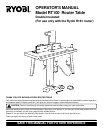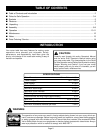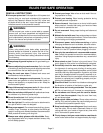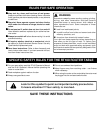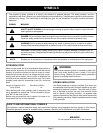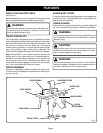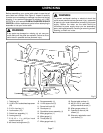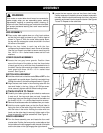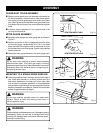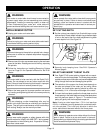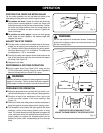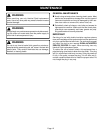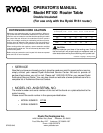
Page 3
RULES FOR SAFE OPERATION
READ ALL INSTRUCTIONS
Know your power tool. Safe operation of this power tool
requires that you read and understand this operator’s
manual, the Operator’s Manual for the R161 router and
all labels affixed to the tool. Learn the applications and
limitations as well as the potential hazards.
WARNING:
Do not connect your router or router table to a power
source until you have assembled and adjusted the
router table as described in this manual and have read
and understood all precautions and operating instruc-
tions in the manual and printed on the tool.
WARNING:
When using electric tools, basic safety precautions
should always be followed to reduce the risk of fire,
electric shock, and personal injury. Use common
sense. Some of these basic safety precautions include
the following:
Always keep all guards in place and in good working or-
der.
Remove adjusting keys and wrenches. Get in the habit
of checking to see that hex keys and adjusting wrenches
are removed from the tool before turning it on.
Keep the work area clean. Cluttered work areas and
work benches invite accidents.
Do not use in dangerous environments. Do not use
power tools near gasoline or other flammable liquids, in
damp or wet locations, or expose them to rain. Keep the
work area well lighted.
Keep children away from power tools. All visitors should
be kept at a safe distance from the work area.
Make the workshop child-proof with padlocks and mas-
ter switches or by removing starter keys.
Do not force the tool. It will do the job better and safer at
the rate for which it was designed.
Use the right tool. Do not force the tool or attachment to
do a job for which it was not designed.
Wear proper apparel. Do not wear loose clothing, gloves,
neckties, rings, bracelets, or other jewelry that could get
caught in moving parts. Nonslip footwear is recommended.
Wear protective covering over long hair.
Always wear safety glasses with side shields. Every-
day eyeglasses have only impact resistant lenses; they
are not safety glasses.
Protect your lungs. Wear a face or dust mask if the cut-
ting operation is dusty.
Protect your hearing. Wear hearing protection during
extended periods of operation.
Secure the work. Use clamps or a vise to hold the work
when practical. It’s safer than using your hand and frees
both hands to operate the tool.
Do not overreach. Keep proper footing and balance at
all times.
Maintain the tool with care. Keep cutters sharp and clean
for the best and safest performance. Follow instructions
for lubricating and changing accessories.
Disconnect power tools before servicing or before
changing accessories such as blades, bits and cutters.
Reduce the risk of unintentional starting. Make sure
switch is in the OFF position before plugging in the tool.
Use only the manufacturer’s recommended accesso-
ries. Consult this operator’s manual for recommended ac-
cessories. Using improper accessories may cause risk of
injury.
Never stand on tool. Serious injury could occur if the
tool is tipped or if the cutter is unintentionally contacted.
Periodically check for worn or damaged parts. Check
for alignment of moving parts, binding of moving parts,
breakage of parts, loose mounting brackets, and any other
conditions that may affect operation. A guard or any other
part that is damaged should be properly repaired or re-
placed. Before the tool is used again, make sure that the
repaired or replaced part is operating properly and per-
forming its intended function.
Direction of feed. Feed work into a blade or cutter against
the direction of rotation of the blade or cutter only.
Never leave tool running unattended. Turn the power
off. Do not leave tool until it comes to a complete stop.
Do not abuse cord. Never yank the cord to discon-
nect it from the receptacle. Keep the cord from heat,
oil, and sharp edges.
Keep cutters clean and sharp. Sharp cutters minimize
stalling. Dirty and dull cutters may cause misalignment of
the material and possible operator injury.
Keep hands away from cutting area. Keep hands away
from the cutter. Do not reach underneath table or in the
cutting path with your hands or fingers at any time while
tool is connected to power source.
Firmly clamp or bolt your router table to a workbench
so the router table surface is at approximately hip height.



